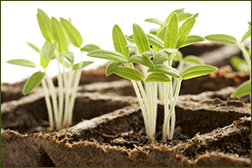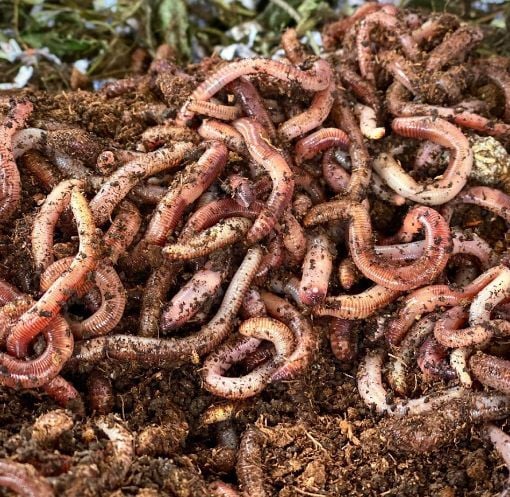 As spring approaches, many gardeners are thinking about growing their own seeds into small plants – called “starts.” Using compost is a great way to give the little plants a healthy start before planting them outside. Uncle Jim’s Worm Farm has several tools and tips for getting your starts up-and-running in time for spring planting.
As spring approaches, many gardeners are thinking about growing their own seeds into small plants – called “starts.” Using compost is a great way to give the little plants a healthy start before planting them outside. Uncle Jim’s Worm Farm has several tools and tips for getting your starts up-and-running in time for spring planting.
Yes, you can buy starts at the garden center if you want. Be aware, though, that you will be limited on the variety. Garden centers only have a limited selection of the best-known and most popular varieties of plants. Did you know that plenty of exotic seeds are available? How about striped tomatoes or heirloom sweet corn in 10 different colors? Those will only come from seeds.
Additionally, most of the starts on the retail market are not organically grown. They may have been treated with pesticides, herbicides and other chemicals. Some are worse for wear after hanging around in a truck and on a shelf. Growing at home puts you in the driver’s seat, and you can control how your starts are treated.
To make your starts, you will need:
- Seeds
- Soil
- Completed compost for fertilizer
- Containers
- Water
Seeds
Look through your local grocery stores, health food stores, and gardening centers to find seeds. You can also order seeds online. Uncle Jim’s carries a selection of heirloom seeds. In general, it will be easiest to choose plants that come from smaller seeds. Also, it’s difficult to make starts for root vegetables such as potatoes and carrots. Good plants for starts are: tomatoes, broccoli, lettuce, etc.
Soil
Where to get soil for starts:
- Buy a package of seed-starting mix at the garden center and mix it with compost, or
- Mix your own. Here is a recipe: 1/3 coconut coir, 1/3 vermiculite, and 1/3 compost.
Compost
Completed compost is an important nutritional boost for the little plants. If you have been cultivating a composting system, you should have plenty of all-natural fertilizer available. When compost is produced using worms, it’s called “vermicomposting.” Red worms eat scrap vegetation and make worm castings (worm poop). This “black gold” is a cherished, organic fertilizer that gardeners swear by. Find out how to harvest compost. Uncle Jim’s offers Red Composting Worms and composters. If it’s too late to start composting, or you just want the convenience, Uncle Jim’s also sells finished compost. This compost is produced by our own worms in Pennsylvania and shipped to your door.
 Containers
Containers
You will need containers to grow the plants in. These can be purchased, or you can save small containers; however, you can save money by making your own containers. Uncle Jim’s has two tools to make this easy: the Paper Potter and the Soil Cube Tool.
The paper potter ingeniously presses sheets of old newspapers into a pot shape. Talk about recycling! These paper pots hold their shape when you add dirt and seeds. It comes in two sizes: Paper Potter Original and Paper Potter Big. When it’s time to plant, plant the entire pot. Newspaper breaks down very easily once exposed to the elements. The delicate roots need not be disturbed, reducing the risk of transplant shock.
Many a seasoned gardener swears by the Soil Cube Tool. This ingenious, money-saving tool eliminates the need for pots. Just follow the instructions and make the seed-starting mix. Use the soil cube tool to press the mix into small cubes. Add seeds. The seed-starting mix is designed to stay together while the seeds grow. Place the whole thing in the ground and let your babies grow.
When your seeds are in place, set them in a warm spot with plenty of sunlight. Keep a close eye on them, and keep them moist. Soon enough, your little sprouts will be big enough to plant in the garden.









10 thoughts on “How to Grow Your Own Garden “Starts” with Compost”
I purchased one of your worm factory 360 about 7 years ago, I absolutely love it. I call it my nursery. Anyway, I have always had a problem with moisture. I don’t have beautiful soil, I have muck. I add only veggie scraps, coffee, tea, and shredded newspaper for bedding. What am I doing wrong, or is this correct? Thanks.
Donna
Hi Donna! Castings typically look like “muck.” Have you changed out the bedding and harvested the castings recently? Worm Castings looks almost like a dark pudding.
Red wigglers like a 75 -85 % moisture content so I am always adding water to my worm farm. I am single and do not have much food scraps to add which have a lot of water in them. I do have and use coffee grounds and used tea leaves and they have moisture in them. But the bulk of what I have and use is shredded paper and cardboard from work which both absorb water so my worm farm runs dryer than ideal.
So if you feel your worm factory 360 has too much moisture add more shredded paper/newspaper / cardboard to get it to your desired level.
I currently have a “poop-smelly” Worm Bin 360 after feeding a the red part of a whole watermelon. I mashed it and mixed it with shredded paper and coffee grounds, adding it to the bin. After a few days it was HOT inside and worms were were diving to the bottom tray – even escaping.
It looks like I added way too much food too quickly and I’ve since taken 3/4 of the smelly part and divided into 3 more rays – each loaded with fresh shredded paper – and rotated so they air out as best as possible. I also mixed the bottom tray, which was filled with dense worm dirt.
What else should I do to recover this issue? I have 2 more bins that I was wanting to add the watermelon rinds to (frozen), along with (frozen) cuttings obtained from floral arrangements for a wedding (~5 gal total).
Thanks in advance (TIA)!
I put corrugated cardboard (and other cardboard that has little or no ink on it like toilet paper tubes) through my shredder and keep a bag by my composter. I just add a large handful or more if my mix is too wet. In my experience newspaper clumps and does not work as well, but I do use some newspaper or brown paper if I don’t have enough cardboard. I add the green rinds but do not add the red part of a watermelon. Think about it – if you drop a watermelon there is nothing left but water, so you are not really adding much besides water. Once in awhile if I have something I think will be too wet I blend it up and throw it on my lawn rather than throw it away. I think the instructions said not to do this, but I mix the top tray with my hands every time I add food to keep the moisture uniform and add some air, and my worms are very happy.
I add fairly dry coconut coir (which I’m kind of in love with cause it’s renewable and a byproduct of coconut oil, water, pulp etc). It’s been working great to sop up extra moisture this rainy spring/summer.
If I get some worms in my container gardening pots will those worms est my roots off my plants?
Hi Thelma,
Your gardening pots will be just fine! Worms only eat dead or decaying matter, and will not eat anything living!
Hi Thelma,
Thanks for reaching out! The worms will not harm your plants. They will live off the the vegetation and dead debri in the pot or you can add a little food for them as well!
Have a great day,
Uncle Jim’s Worm Farm Team
I bought your worm factory about 2 months ago. I’m only on my first tray so far but the worms are doing great! I recently started some seeds in little pots with seed starter soil. They have just started to come up. Is it ok to add some of the black gold from my tray to the seedlings now?